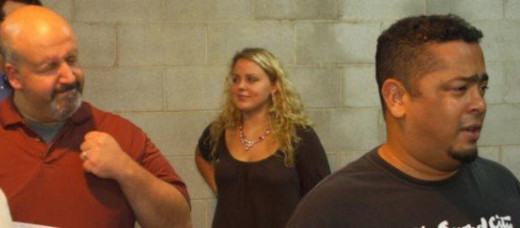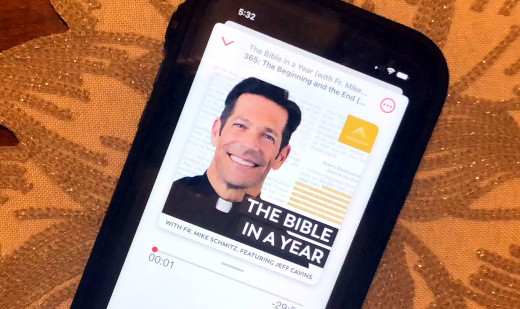He Had Our Backs

The expression “I’ve got your back” is one of great support. I first learned this early in my work career when I worked in consulting. It was never a good practice make a colleague look bad in front of the client, and fellow consultants would have someone’s back – they would try to smooth the situation, and deal with it later on out of the client’s purview. Over the years it evolved to where co-workers or managers would purely support you. I have always been aware of who these people have been and have greatly appreciated their support.
This expression also came up several years ago when I was active in improv comedy. The idea behind improv is not to make jokes rather to “build and heighten” a story, to “yes, and” your fellow performers on stage and support them. It is through this that the funny comes out and the humor comes to life. Just before I and my fellow improvisors – whether the entire troupe we called Blue Shampoo or just a few of us – hit the stage, we would always give each other a hug and tell each other, “I’ve got your back.” It was a reminder to them, and most importantly to ourselves, of what we were about to do.
One shining moment when someone truly had my back was a short scene between myself and another improvisor I remember to this day like it was yesterday. As many say improv is “throw-away” comedy, for the reasons I will retell here this moment was so memorable.
See What I Saw
One night myself and a couple of members of my troupe, Linsey and Christopher, decided to sign-up for “barprov.” As you might guess by the name, it was improv at a bar – we would perform on stage at the back of a bar in Chicago on a week night when there normally wasn’t a band playing. We would perform for free in exchange to practice our craft. The audience was mostly other improvisors, and the bar made out from our consumption of libations over the course of the night.
When it was our turn, we did a number of short scenes – sometimes it would be all 3 of us, sometimes 2 of us. When we got as far as we could with a scene, one of us would shout “scene” to end it and we would mix it up. Occasionally if a scene was going nowhere one of us who was off-stage could also shout it to keep the night moving.
On one change of scene it was myself and Linsey on the stage. He turned sideways and looked at me, and I turned and looked back at him. Linsey then swung around one of his legs and put it back down, at which he gave me a look with a raised eyebrow and a slight nod. I took this as a cue to do the same, which I did. Many times in improv we would let someone take the lead, not necessarily knowing where they were going. After I swung my leg, Linsey then squatted down, giving me the same gesture as before. So I squatted down, and as I did, Linsey stood up. Getting that same nod again, I stood up and he squatted down again.
Then it hit me... we were on a see-saw!
What I don’t remember from this scene was the dialog, but I recall it had nothing to do with being kids nor an acknowledgement of the see-saw. We continued the scene until one of us called it and we continued along with our time on stage. Afterwards however, we were ecstatic at how the scene turned out and all of us were hugging and laughing. We were on a see-saw – it was brilliant! As we often would critique our performance and highlight the positive, we couldn’t stop talking about the see-saw. And it wasn’t just that night – the see-saw would come up time and time again. For me it was a pivotal moment – it was a great and funny scene, but it was also the epitome of Linsey having my back, yet pushing me forward as an improvisor. It was a highlight of the time I was active in improv.
I have been thinking about the see-saw scene again recently as I got word that Linsey Falls died late last year. It was a complete shock to me and others very close to him, especially Christopher Donaldson, the other improvisor whom we were performing with that night for barprov. The 2 of them became great friends from improv and for years performed together including as The Gentleman’s Follies, where they played time-traveling vaudevillians. Yes, it was as funny and enjoyable as it sounds.
Sadly I hadn’t been in touch much with Linsey in recent years, occasionally connecting over social media. He was a member of the company at Playmakers Laboratory, which was called Barrel of Monkeys when I was in Chicago, and it was through knowing him that I was asked to serve on their board of directors which I proudly did for 2 years. Though it was infrequent, whenever we did connect it would be like old times, and I look forward to that reconnection someday in that better place where he is now.
There was an outpouring of love and thoughts about Linsey on social media, and a tribute to Linsey was written in the Chicago Reader. Christopher is quoted in the story along with a photo of the 2 of them. As a result of this sad news I reconnected with Christopher, a brilliant actor, writer, improvisor and human being in his own right. Our exchanges were about a man who had a lasting impression not only on ourselves but on the Chicago theater community as a whole.
I recall one night at a Chicago bar after a practice or show and the topic of fame came up in the conversation among our troupe. For myself, improv was a creative hobby but for the rest it was their calling, especially as many like Linsey had moved to Chicago to do improv. I remember Linsey saying that he didn’t want to be famous, rather he wanted to be known in the improv and theater community. To this he was more than successful, and Linsey Falls will be dearly missed.
This is from The Hot Iron, a journal on business and technology by Mike Maddaloni.
Did you enjoy this? Subscribe to The Hot Iron by RSS/XML feed or Read by Email
Announcements • Diversions • (0) Comments • PermalinkMy Takeaways From The Bible In A Year Podcast
Of all the books I read in 2023 I actually read them – they were all physical, paper books and none were audiobooks (with no disrespect to those who are in the audiobook business, but I digress). As much as I’m driving the kids to the various activities one might think I’d be into audiobooks. I’m not, as I’m listening to podcast and music while driving. Books are an enjoyable getaway from the mundane and I enjoy the tactile experience.
One book I was planning to read was the Holy Bible. Despite being the good Catholic boy I (think that I) am, I have never actually sat down and read the Bible. I’ve read passages from it when directed to it in my religious education but as a Roman Catholic, we are fed a digested version in our weekly readings and gospels at mass. Shortly into January of last year I learned about The Bible in a Year Podcast. Where I didn’t have a whole lot of information on it I figured I’d give it a try and started with the first episode. I was immediately hooked and I made it through each and every episode.
The Bible in a Year Podcast is hosted by Fr. Mike Schmitz, a priest who serves at the University of Minnesota – Duluth. In each episode he reads from The Great Adventure Catholic Bible, a version of the bible available from Ascension Press, the publisher of the podcast. Each episode includes readings, psalms and verses followed by discussion and interpretation of what Fr. Mike just read. In addition to Fr. Mike, an occasional guest is Jeff Cavins, a lay Bible scholar who is the editor of the Great Adventure Catholic Bible, who provided additional commentary and insight throughout the year.
So can one have takeaways from experiencing the Bible as a podcast?
Heard the source – As I mentioned before, in a Catholic Mass we have readings and a gospel each week and they are taken from the Bible. Going through The Bible in a Year Podcast I actually heard the “raw” Bible, or at least how it has been translated. For example, the Prayer of Aaron, which I learned from my pastor in Boston, comes from the Book of Numbers, Chapter 6.
That’s in the Bible? – It was interesting to hear some of the passages in the Bible. There were a lot of stories and tales that I wouldn’t at face value consider prayers or relevant stories. Then there’s the rather intricate description of the Arc of the Covenant which went into details on its size and materials used to build it, or the Book of Numbers which was just that, full of numbers. The podcast also had a mature audience warning because there are some themes in it that are probably not appropriate for young kids.
Need more priests like Fr. Mike – To say Fr. Mike is enthusiastic and energetic is an understatement. I’ve only met a few priest in my lifetime to have that kind of energy and are not preaching down to you. Many priests are all “fire and brimstone” and leave you with a guilty feeling. Sure Fr. Mike is a younger priest, but I wouldn’t say that’s necessarily the reason as my former priest in Boston, Fr, Joe, was an older priest and was simply amazing. We need more priest like this, and of course I say this realizing there’s a shortage of priests throughout the world because people just don’t take up the vocation.
In the new year, I decided to further my religious study journey by listening to The Catechism in a Year podcast also from Fr. Mike. It’s still early so check back in a year and see if I make it all the way through and my takeaways from it. I may also pick up my own copy of The Great Adventure Catholic Bible and follow The Bible in a Year podcast again in 2025, but this year first.
If you are Catholic or Christian or just curious, I recommend The Bible in a Year Podcast. As it’s still early in 2024 you can go back and start from the beginning and catch up on each episode which vary from about 20 minutes to a half an hour each day. As this is something that I can’t physically pass along to others, I pass this along to you in words and spirits.
This is from The Hot Iron, a journal on business and technology by Mike Maddaloni.
Did you enjoy this? Subscribe to The Hot Iron by RSS/XML feed or Read by Email
Diversions • Thrive • (2) Comments • PermalinkBuy My Chicago Loop Condo
City living. It’s not for everyone, but for those that appreciate it being in the heart of it all is where to be. From entertainment to restaurants to parks to shopping, the right location matters. When it comes to Chicago, there’s no better place than in the Loop, and no better place than Five North Wabash and this 1-bedroom and den condo now for sale.
Here’s your opportunity to experience city living at its finest in the right location. Located on Wabash Avenue, around one block to Michigan Avenue and Millennium Park and the other to State Street and great shopping and dining. A few blocks beyond Michigan Avenue is the Lake Michigan lakefront, with trails extending for miles north and south. Back on Wabash, right outside the door is the CTA “L” train stop which can connect you north on the Brown Line and the Orange Line to Midway Airport, or a few blocks away for the Blue Line to O’Hare. And don’t forget food, as within steps is great Chicago-style pizza, sushi, coffee, Raising Cane’s and more.
This is an ideal location for working professionals, people looking for a getaway place in the city or college students. It’s a few blocks to the heart of the Loop and most offices, and the Green Line and buses can take you to the West Loop. Looking to spend the weekends in the city? You can walk to most downtown theatres and restaurants and the rest of the city is a train or shared ride away. Not to mention the ease of getting to every major sporting venue in the Windy City. For students it’s in close proximity to the urban campuses of the School of the Art Institute, DePaul University, Columbia College and Roosevelt University.
But don’t take my word for it – check out the complete listing here complete with photos. See the large, high ceiling 1-bedroom, den which can be made into another bedroom, spacious living room, furnished kitchen, in-unit washer/dryer, and enhanced closet. Don’t forget the large storage room just down the hall too. If you’re interested, please contact Will and Lisa Barroso, out real estate experts – all contact info is on the listing.
My wife and I have decided to sell this condo we have owned in the Loop as it’s clear we are sticking around Wisconsin for a little while. This was our home for many years. Where we miss the Second City and will miss this place, it’s now time for others to make memories in this unique space just as we did.
This is from The Hot Iron, a journal on business and technology by Mike Maddaloni.
Did you enjoy this? Subscribe to The Hot Iron by RSS/XML feed or Read by Email
Announcements • Diversions • (0) Comments • PermalinkLet It Snow THEN Decide If To Close

“Oh the weather outside might be frightful,
But the idea of a snow day is so delightful,
And since we don’t know the way the forecast will go,
Let it snow, then decide if to close!”
With no apologies to the late Sammy Cahn, I share with you what has transpired over the last day. Yes, this is part rant and part constructive criticism as well.
Yesterday around 4 pm, I got an alert for my kids’ school system stating that classes would be canceled today due to a looming snow storm. Where I didn’t feel like looking at the forecast myself, some people told me we would be getting a few inches to a foot of snow during what was being called Winter Storm Avree. As the snow was supposed to start overnight and dramatically impact rush hour traffic, school was proactively canceled in the name of safety the day before it was to happen. Canceled not just in my fair town but in a majority of the State of Wisconsin in the US upper Midwest, an area that is not unfamiliar with snow in January.
When I awoke this morning, there were signs that school was certainly canceled. A plethora of dishes and implements from the late-night baking my kids did as they didn’t have to get up early filled the kitchen. However when looking out the window, there was a mere dusting of the white stuff in the street and there were bare spots on the driveway and sidewalk at my home. Way to go Avree.
So much for the snow, and the concerns of safety that compelled government officials to cancel education for a day. As I write this it is over 24 hours from when the cancellation notice was sent, but nothing even close to white-out conditions that would make it unsafe to travel in the morning. Even as it snowed later in the day into the evening, it was certainly navigable out.
Golden Snow Days
The events of the last day are a far cry from what life was for me when I was growing up in the 1970’s and 1980’s. School cancellations would happen in the morning of the school day. Us kids would get up earlier in the morning to huddle by the radio to hear if our school system was cancelled. What was told to me years later by the assistant superintendent was the decision was made early in the morning, considering the forecast and what was happening outside their window, and then phoned into the radio and TV stations along with the secret password so some wiseass wouldn’t just call in a bogus cancellation.
This approach followed me from public schools to even college, as they were slow to never cancelling classes. Where it was always nice to have a day off, the reality was that I was in New England, snow happened in the winter, and we had to deal with it. This was the assumption I had when I moved to Wisconsin, as I previously alluded to.
Today is not Yesterday
So what has changed? Is it the litigious society we live in? Is it a by-product of the recent lockdowns? Is there an assumption that more parent are home (albeit working) so if closing classes are canceled the kids can stay domicile with the parents or families who will already be there? Are we simply not as tough as we used to be? I am sure if I pose this question directly to a school bureaucrat I will be returned with a scripted response laced with safety as the paramount concern, but not acknowledging my reservations for the kids staying home, especially as report after report continues to come forth on the negative impact of school closings over the past few years on kids performance in school.
Somewhere in the middle is a happy medium. But who wants to meet in the middle these days? Fortunately we got enough snow to make a decent snowman as secondary compensation. The primary compensation will be classes in session tomorrow.
Deconstructing Weather Related School Closings
Safety is always a concern in all we do. But the process that goes into determining what is safe or not has to be reviewed to ensure it makes sense, and take into consideration possible collateral damage as a result of any decisions made. The best place for kids to be for learning is in person and all reasonable actions should be made to ensure this happens as much as possible.
This is from The Hot Iron, a journal on business and technology by Mike Maddaloni.
Did you enjoy this? Subscribe to The Hot Iron by RSS/XML feed or Read by Email
Diversions • Strategize • (0) Comments • PermalinkThe Hot Iron At 17

What better a way to celebrate a birthday than with a cake? As these days I am not eating the ingredients you typically make a cake with, I went to OpenAI’s DALL-E AI image generator to make one. As you can see from the accompanying image with post, I have some major work to do on my prompt writing in the new year.
That being said, I didn’t put much time and thought into my prompts, which are the natural language queries you enter to get an image. Of all of the prompts and adjustments to them, this image was the best of them all.

Where I don’t have plans to use AI to create major portions of the content of this blog, you the reader should expect to hear more about it as I – and most of the known world – will be thinking and acting on AI in the future. If something is AI-generated, I will also note it as such. I do hope to have more timely topics that live up to the genesis of the name of this blog, along with takeaways and giveaways of the books I read. That being said I don’t want to get ahead of myself as I suck at predictions, especially when it comes to my productivity with my humble blog.
Happy 17th to The Hot Iron and a Happy 2024 to you!
This is from The Hot Iron, a journal on business and technology by Mike Maddaloni.
Did you enjoy this? Subscribe to The Hot Iron by RSS/XML feed or Read by Email
Announcements • Blogging • Build • (0) Comments • Permalink


